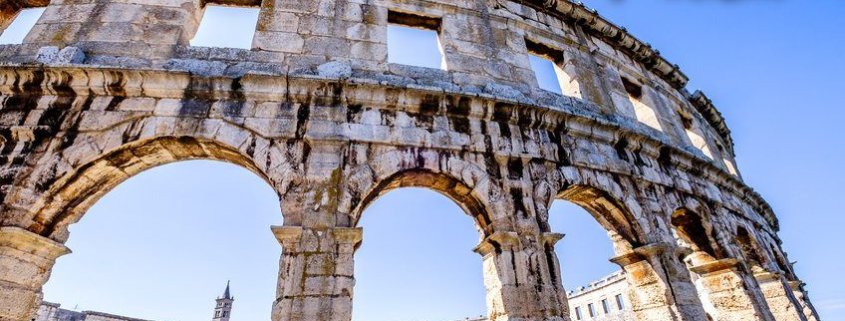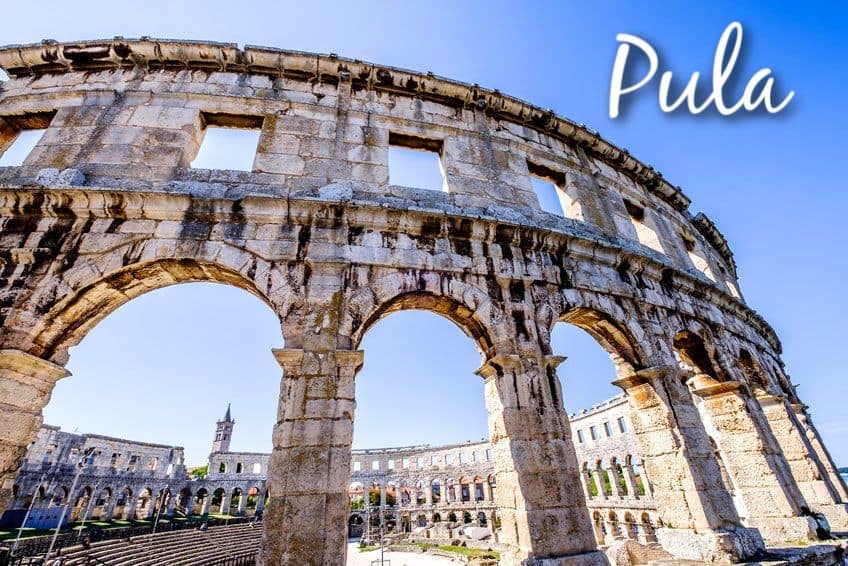
Situated near the base of the Istrian peninsula, the population of Pula stands at just over 62,000 making it the largest city in Istria. Its most famous attraction, the well-preserved Roman amphitheatre, is one of the most famous sights in the whole of Croatia.
If you’re here for a city break, take a look at our Two Days in Pula itinerary for how to make the most of your time.

Getting to Pula
Pula has an international airport, with a number of flights from the UK and Ireland and other cities in Europe to there – see our Getting to Istria page for details. You can use the Brioni / FILS shuttle buses to travel from the airport to the main bus station in Pula, or other destinations in Istria. Take a look at our Getting to and from Pula Airport page for details on how to transfer from the airport.
You could also fly to Trieste and then get a bus to Pula, or fly to Venice and either get a bus or a catamaran to Pula.
History
Although the amphitheatre in the town announces Pula’s Roman origins, its history in fact stretches far, far beyond this period. Archaeological findings in the area suggest that Pula’s history stretches back to 40,000 or even 1 million years BC!
It was however in the 11th century BC that Pula rose to prominence when it became a major settlement for the Illyrian tribe the Histri. After expansion by the Roman Empire into Istria in 177 BC, in 40 BC Pula became a Roman colony and grew rapidly during the years 27 BC to AD 14 under Emperor Caesar Augustus. During this time several important buildings were constructed (including the amphitheatre) and the town rose in strategic and economic significance for the Romans, with local trade becoming rather important.
After the fall of the Roman Empire, Pula fell under the control of various groups, including the Eastern Goths for 45 years to 538 when it became part of the Byzantine Empire, until the Slavs began their colonisation in the early part of the 7th century.
As with the rest of Istria, Pula fell under the control of the Venetians in 1331 and at the time the town had both strong Slavic and Roman influences. In was under Venetian control that Pula unfortunately suffered from numerous plagues and attacks from other groups (the Habsburgs, for one) and its population dwindled – by the 16th century, there were only 1,000 citizens (down from 5,000 in the previous century) and by 1631, only 300 people lived there.
Pula finally recovered in part during the 19th century when, now in the Austro-Hungarian Empire, it was proclaimed the chief port of the Empire in 1853 and the population rose once more as industry grew and workers flocked to the town. Around this time, Pula had a large German and Italian population.
After World War I, Pula (and Istria) became part of Italy and the majority of Croatians suffered oppression during this time as their rights were not respected.
After World War II ended in 1945, Pula was administered by the United Nations and British and American units. It finally became part of Yugoslavia in 1947, and was then part of Croatia when it declared its independence in 1991.
Sightseeing in Pula
Please see our special page on Sightseeing in Pula.
Eating and Drinking in Pula
Farabuto (Sisplac ulica 15) is a little off the beaten track in terms of location – slightly away from the main sights – but the dining here is so really worth it. The menu is small but that’s even better, for the quality of the dishes is superb and everything is so wonderfully presented. The options largely revolve around seafood and fish, although there are some steak options too. An absolute must is the seafood appetizers for two as a starter before you move on to the seafood risotto, the stew from octopus and cuttlefish or local tuna prepared with a plum sauce with “Roman gnocchi” (large cubed gnocchi). Service is very warm and friendly too.
Epulon Food & Wine (Epulonova 4) offers a wonderful range of Istrian dishes – and wine – in a smart setting in the centre of the city.
KonobaBoccaporta (Dolinka 18) used to be located in Pomer (close to Medulin) but moved to Pula in 2014. A wide variety of meat and fish dishes, which are all recommended – try one of the platters to sample several tasty items at once.
Tivoli (Veli vrh 1) is one of the top choices if you’re hankering after some good quality pizza. Plenty of choice on their menu with some pasta options as well.
Pomaj (Istarska ulica 38 and ulica Sergijevaca 14) serves up exceedingly tasty ice cream, just the thing to reward yourself with after some sightseeing. They of course have multiple flavours, but you really must try the olive oil one – it sounds unusual, but it really works! When in Pula, and all that…
Shipyard Pub (ulica Svetog Teodora 1) is the place to come for evening drinks – there’s normally always a great atmosphere in its large central courtyard. Open until 2am on the weekends.
Day Trips from Pula
Take a look below at some of the top tours you can take in and around the Pula region:
Pula Trivia
Author James Joyce stayed in Pula for five months from October 1904. He arrived to teach English to Austrian officers at the Berlitz language school. Despite calling Pula a “naval Siberia”, he is thought to have written part of his first novel Stephen Hero there, was well as working on his classic A Portrait of the Artist as a Young Man. A bronze James Joyce now sits at Uliks (Ulysses) cafe in the town.
Italian poet Dante Alighieri mentioned Pula in his Divina Commedia.
The Pula Film Festival is one of the oldest film festivals in Europe, and over the years has attracted glamorous acting greats such as Elizabeth Taylor, Richard Burton and Orson Welles.
Accommodation in Pula
Use the search map below to look up places to stay – both hotels and rentals – in the city:
For more options, please see our special Accommodation in Pula page.
General Info
The area code is 052.
The Tourist Office is situated at Forum 3, tel: 052 219 197, fax 052 211 855, email: info@istria-pula.com.
For more info, point your browser to the Tourist Office website, or the Istria Tourist Board’s section on Pula.
